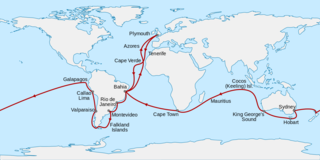Creativity
Charles Darwin: A Life of Illness and Creativity
A look at the development of his work and the sickness that he endured.
Posted March 8, 2022 Reviewed by Michelle Quirk
Key points
- Charles Darwin's life was "one long struggle against the weariness of strain and sickness."
- His doctors prescribed a variety of treatments including mercury and weak hydrochloric acid, to no avail.
- Darwin recognized an association of many of his symptoms with stress, and he led an isolated life to mitigate it.
In an earlier posting, I summarized the life of Herman Melville as a model for exploring the relationship of creativity and mental illness in writers and artists. In this article, we will extend these thoughts to scientists by looking at Charles Darwin, who over the course of his troubled life developed the concept of evolution by natural selection, thus profoundly altering the course of biological thinking for generations. He is also something of a transitional figure, in that his life’s work interacted with both poetry and art. He may have been influenced by the poetry of his grandfather, Erasmus Darwin, who, in "The Temple of Nature," had speculated about what came to be known as evolution and the origins of mankind. Charles also made many drawings of his specimens, worked with artists to make others, and was one of the first to use photographic illustrations in his books. In this first post in a two-part series, we’ll consider his story up to the publication of his landmark book On the Origin of Species1; in the second part, we will look at the rest of his life and its medical and psychiatric implications.
Born in 1809 in Shropshire, he was the son of Robert Darwin, a wealthy doctor and financier, and his wife, Susanna, a member of the Wedgwood family, famous for manufacturing fine porcelain and china. When he was eight, his mother developed abdominal pains and died a few days later, likely due to infection, and he was raised largely by his older sisters. He was a generally healthy and vigorous teen whose main enthusiasm was for hunting and shooting, though he was troubled occasionally by stomach upsets at breakfast and outbreaks of boils. His father, worried about his seeming lack of serious interests, enrolled him at age 16 in the medical school at Edinburgh University. He quickly lost interest in medicine, apparently distressed by witnessing surgery, but was stimulated by teachers into studying natural sciences, particularly marine invertebrates. His father began to believe that an education as an Anglican clergyman might provide more structure to his life, and transferred him to Christ’s College, Cambridge. There he was able to enjoy the pastimes of young gentlemen, but also came under the influence of traditionally trained naturalists, accompanying one on a trip to study the geology of Wales. After he graduated in 1831, one of his botany teachers suggested that he join a voyage on the HMS Beagle to the southern tip of South America and beyond. Rather than serve in the crew, he enthusiastically paid his own way as a companion to the aristocratic captain who desired time with someone of his own class and upbringing.
A Voyage Around the World
Darwin arrived in Plymouth in October 1831, excited but also anxious about leaving his family and the world he knew. The beginning of his adventure was not propitious; the Beagle set out twice unsuccessfully, forced back by gales, and was delayed again after excessive carousing at Christmastime. "These two months at Plymouth were the most miserable which I ever spent," he later wrote. "I was also troubled with palpitation and pain about the heart, and like many a young ignorant man, especially one with a smattering of medical knowledge, was convinced that I had heart disease. I did not consult any doctor, as I fully expected to hear the verdict that I was not fit for the voyage, and I was resolved to go at all hazards."2

Finally, on December 27, 1831, the Beagle successfully began its five-year voyage. It was a trying time for Darwin’s health. In addition to persistent seasickness, he suffered from fevers, boils, heat stroke, food poisoning, and inflammation of the knee and arm. Despite these difficulties, his studies were prodigious. In the Cape Verde Islands, he was fascinated with the bands of oysters embedded in the cliffs and speculated about the shifts in the landscape across time. He marveled at the rainforests of Brazil, and in Patagonia discovered the fossilized bones of huge ancient mammals. In the Andes, he made watercolors of rock formations and found seashells and fossilized seashore vegetation. In the Galapagos, he noted how mockingbirds and finches had different characteristics on each island. He collected thousands of specimens of fossils, insects, plants, birds, eggs, and nests, many of which he shipped back to England along the way. He had begun the voyage as a 22-year-old planning to become a clergyman, who was indulging his interest in biology and geology; he returned as an experienced scientist with growing recognition from the materials he had sent ahead, armed with voluminous notes from the journey.3
Darwin began working in London in March 1837, writing and categorizing his specimens. Initially, his health was good, but after about 18 months he developed abdominal pain with frequent nausea and vomiting (often after every meal), which would afflict him for many years to come. He complained of palpitations, insomnia, numbness in his fingers, tremor, a buzzing sound inside his head, and depressed mood. His son Francis described his life as "one long struggle against the weariness of strain and sickness" (Darwin, 1887).
The Secluded Years
By 1842, Darwin had finished an outline of his thoughts on natural selection and sought solitude, which he thought would improve his health, in a former parsonage in the small village of Downe, in Kent. He avoided scientific meetings and their resultant stress whenever possible. He continued to worry about the condemnation with which his ideas were likely to be received in the clergy-dominated atmosphere of the time. This was a difficult period for him, particularly with the death by typhoid of his oldest daughter, Annie, in 1851, which led him to question his religious beliefs. His many physical symptoms continued and were not helped by doctors' suggestions of drinking solutions of mercury or weak hydrochloric acid. He sought relief on his own at spas and with treatments such as affixing batteries to his abdomen or heating followed by cold baths.
By the 1850s, he believed that a growing secularization of science and society might lead to greater acceptance of his ideas. He began organizing and writing his thoughts going back over two decades in a work he tentatively entitled Natural Selection. Despite the stress of finding that his tenth child, Charles Waring Darwin, was developmentally disabled, he continued to work, and by 1858 had a substantial manuscript in hand. It was then that he received a professional shock: Alfred Russel Wallace, a biologist working in the Dutch East Indies, sent him an essay outlining ideas about natural selection that closely mirrored Darwin’s. Greatly distressed, Darwin consulted his colleagues, the geologist Charles Lyell and botanist Joseph Dalton Hooker, who formulated a plan: They would present the work of both men jointly at a scientific meeting in July 1858. Darwin himself, dealing with the recent death from scarlet fever of his son, was unable to attend. He continued working frantically on his manuscript. When the book, now entitled On the Origin of Species, came out in November 1859, the 50-year-old Darwin was away at a spa in a remote area of Yorkshire.
This article was adapted from Fragile Brilliance: The Troubled Lives of Herman Melville, Edgar Allan Poe, Emily Dickinson and Other Great Authors.
References
1. Darwin, C.R.: On the Origin of Species, 1859. The Science Classic, T. Butler-Bowden, series editor, (Capstone), Feb. 2020 edition.
2. Darwin CR. Autobiography 1809–1882, (Edited by Barlow N, Freeman (1958), and Pickering W (1989). In: Darwin F, ed. Life and Letters of Charles Darwin. London: Murray, 1887.
3. American Museum of Natural History: A trip around the world. (Part of the Darwin exhibition.) Accessed April 8, 2021.
https://www.amnh.org/exhibitions/darwin/a-trip-around-the-world


